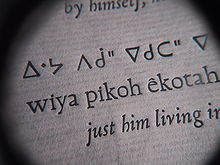- Cree syllabics
-
Aboriginal peoples
in CanadaFirst Nations · Inuit · Métis
This article is part of a seriesHistoryPoliticsCrown and Aboriginals
Treaties · Health Policy
Royal Commission
Indian Act · Politics
Organizations · Case law
Indian Affairs CanadaCultureAboriginal cultures
Aboriginal personalitiesDemographicsLinguisticsReligionsIndexWikiprojectsPortal
Aboriginal Canadian portal
WikiProject
Indigenous North Americans
First Nations
Commons · Wiktionary
Inuit
Métis
Commons · Wiktionary
Commons · Wiktionary A proof from freshly made Cree typeface
A proof from freshly made Cree typeface
Cree syllabics, found in two primary variants, are the versions of Canadian Aboriginal syllabics used to write Cree dialects, including the original syllabics system created for Cree and Ojibwe. Syllabics were later adapted to several other languages.[1] It is estimated that over 70,000 Algonquian-speaking people use the script, from Saskatchewan in the west to Hudson Bay in the east, the US border to Mackenzie and Kewatin in the north.[2]
Contents
History
Cree syllabics were developed by James Evans, a missionary in what is now Manitoba, during the 1830s for the Ojibwe language. Evans had originally adapted the Roman alphabet to Ojibwe (see Evans system), but after learning of the success of the Cherokee syllabary, he experimented with invented scripts based on his familiarity with shorthand and Devanagari.[1]
When Evans later worked with the closely related Cree, and ran into trouble with the Latin alphabet, he turned to his Ojibwe project and in 1840 adapted it to the Cree language.[2] The result contained just nine glyph shapes, each of which stood for a syllable with the vowels determined by the orientations of these shapes. With the 1841 publication of a syllabics hymnbook, the new script spread quickly. The Cree valued it because it could be learned in just a few hours, and was visually distinctive from the Latin script of the colonial languages.[1] Virtually all Cree became literate in the new syllabary within a few years. Evans taught by writing on birchbark with soot, and he became known as "the man who made birchbark talk".[3]
Structure
Canadian Aboriginal syllabics are unique among abugida scripts in that the orientation of a symbol, rather than modifications of its shape or diacritic marks, determines the vowel of a syllable. Each basic shape corresponds to a specific consonant sound; this is flipped or rotated to denote the accompanying vowel.
Like the Latin alphabet, syllabics are written from left to right, with each new line of writing directly under the previous one.
Variants
The Evans syllabary continues in use for dialects of Cree west of the Manitoba-Ontario border as Western Cree syllabics. John Horden[citation needed] introduced modifications in the 1850s in the James Bay area.[2] These were standardized in 1865 to form Eastern Cree syllabics, used today for many eastern dialects of Cree, Naskapi, and Ojibwe, though Cree dialects of eastern Quebec use the Latin alphabet. The two versions differ primarily in the way they indicate syllable-final consonants, in how they mark the semi-vowel /w/, and in how they reflect the phonological differences between Cree dialects.[1] There are more minor local differences in orthography, shapes of the characters, writing styles, and punctuation, with some writers using dots or spaces between words, and others not indicating word separation.[1]
Modern usage
Though used for manuscripts, letters, and personal records since the 18th century, the need for special type long restricted printed syllabics to missionary publications. However, with the development of syllabic typewriters and later word processors, control of the script passed to native speakers, and it is now used for schoolbooks, periodicals, and official documents.[1]
See also
- Canadian Aboriginal syllabics
- Western Cree syllabics
- Eastern Cree syllabics
- Inuktitut writing
- Unified Canadian Aboriginal Syllabics (Unicode block)
- Journal of Indigenous Studies
Cree books written in syllabics
- Hundreds of Eastern James Bay Cree books were published by the Cree School Board of Quebec, Canada. See the catalogue.
- Hymn Book. (By James Evans) Norway House, 1841.
- Catechism. (Transl. James Evans) Rossville, É.N.
- The Holy Bible. (Transl. John Sinclair, Henry Steinhauer) London, 1861.
- Bunyan: Pilgrim´S Progress. (Transl. John Sinclair) Toronto, 1900.
- Cree Hymn Book. (By John Mcdougall) Toronto, 1888.
- Cree Hymn Book. (By Robert Steinauer, Egerton Steinauer) Toronto, 1920.
- The Epistle of Paul The Apostle To The Galatians. (Transl. Joseph Reader) Oonikup (Northwest Territory), S.A.
- The Acts of The Apostles And The Epistles. London, 1891.
- The Books of The New Testament. London, 1859.
- The Epistle of Paul the Apostle to the Ephesians; the Epistle of Jacob; the First Epistle General of John. (Transl. Thomas Hullburt) Rossville, 1857.
- The Travellers´ Spiritual Provision (Calendar) S.L., S. A.
- The Handbook to Scripture Truth: Words of Admonition, Counsel and Comfort. Toronto, 1893.
- Prières, Cantiques, Catéchisme Etc. En Lanque Crise. Montreal, 1886.
- The Book of Common Prayer, (Transl. John Horden) London, 1889 (Addl. Printings Through 1970).
References
- ^ a b c d e f Nichols, John (1996). "The Cree Syllabary". In Peter Daniels. The World's Writing Systems. New York: Oxford University Press. pp. 599–611.
- ^ a b c Campbell, George (1991). Compendium of the World's Languages, 2nd ed.. pp. 422–428.
- ^ Mona Baker, Kirsten Malmkjær (2001:364) Routledge Encyclopedia of Translation Studies
- Barber, F. Luis: James Evans and the Cree Syllabic. In: Victoria Library Bulletin Toronto. July 1940. vol. 2. No. 2. 16 p.
- Burwash, Nathaniel: The Gift to a Nation of Written Language. S.l., 1911. 21 p.
- Evans, James: Cree Syllabic Hymn Book. Norway House, 1841. In: Bibliographical Society of Canada; Facsim. Series 4. Toronto, 1954. 23 p.
- Ray, Margaret: The James Evans Collection. In: Victoria Library Bulletin Toronto. July 1940. vol. 2. No. 2. 16 p.
External links
Categories:- Central Algonquian languages
- Cree language
- Syllabary writing systems
Wikimedia Foundation. 2010.

